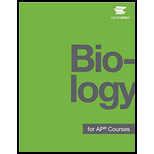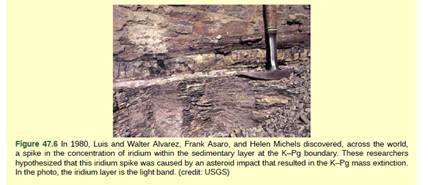
Concept explainers
Figure 47.6 Scientists measured the relative abundance ot fern spores above and below the K-Pg boundary in this reck sample. Which of the following statements most likely represents their findings?
- An abundance of fern spores from several species was found below the K-Pg boundary, but none was found above.

Introduction:
The K-Pg extinction or K-T extinction called as Cretaceous Paleogene extinction eliminated 80% of all species of animals and plants about 66 million years ago. We can see at the boundary between the terrestrial and marine ecosystem, there were present high levels of iridium metal that was said to be from the asteroid that had hit earth. There was huge amount of organic matter that was obtained by the decay of destruction of plants leading to growth of fungi as these are saprophytic and thrived for many years.
Answer to Problem 1VCQ
Correct answer:
The correct answer is option (a) A lot of fern spores from several species was found below the K-Pg boundary, but none was found above.
Explanation of Solution
Explanation/justification for the correct answer:
Option (a) A lot of fern spores from several species was found below the K-Pg boundary, but none was found above. During that period, there was the destruction of plants that lead to a proliferation of fungi as these are saprophytic and thrive on dead matter. The general environment was dominated by photosynthetic organisms namely ferns that lead to an increase in fern throughout the geological area. The spores were found below the boundary as it dominated over the other angiosperm pollen grains.
Explanation for incorrect answers:
Option (b) A lot of fern spores from several species was found below the K-Pg boundary, but none was found below. With the destruction of plants, fungi developed in large numbers as these are saprophytic dominating the other angiosperms. The spores were found to below the boundary. Hence, this option is not correct.
Option (c) A lot of fern spores from several species was found both above and below the K-Pg boundary, but only one species was found below the boundary and many species were found above the boundary. With the destruction of plants, fungi developed in large numbers as these are saprophytic dominating the other angiosperms. The spores were found to below the boundary. Hence, this option is not correct.
Option (d) Many species of fern spores were found both above and below the boundary, but the total number of spores was greater below the boundary. With the destruction of plants, fungi developed in large numbers as the spore dispersal allowed to show dominance. Though the ferns faded, their spores were found below the boundary. There were many types of spores found and not only one. Hence, this option is not correct.
Scientists measured the relative abundance of fern spores above and below the K-Pg boundary in this rock sample. With the destruction of plants, fungi developed in large numbers as the spore dispersal allowed to show dominance. Though the ferns faded, their spores were found below the boundary.
Hence, the statement (a) is correct.
Want to see more full solutions like this?
Chapter 47 Solutions
BIOLOGY FOR AP COURSES (OER)
Additional Science Textbook Solutions
Biology: Life on Earth (11th Edition)
Microbiology with Diseases by Body System (5th Edition)
Campbell Biology (11th Edition)
Genetic Analysis: An Integrated Approach (3rd Edition)
Campbell Biology: Concepts & Connections (9th Edition)
Applications and Investigations in Earth Science (9th Edition)
- Can you fill out those termsarrow_forwardExplain down bellow what happens to the cell: Decreased pH in mitochondria Increased ATP Decreased pH in cytosol Increased hydrolysis Decreasing glycogen and triglycerides Increased MAP kinase activity Poor ion transport → For each one:→ What normally happens?→ What is wrong now?→ How does it mess up the cell?arrow_forwardAn 1100 pound equine patient was given 20 mg/kg sucralfate 3 times a day, 2.8 mg/kg famotidine twice a day, and 10mg/kg doxycycline twice a day. Sucralfate comes as a 1 gm tablet, famotidine as 20 mg tablets, and doxycycline as 100mg tablets. All are in bottles of 100 tablets.How many total mg are needed for the patient and how many tablets of each would be needed to provide each dose?How many bottles of each would be needed to have available if this patient were to be on this drug regimen for 5 days?arrow_forward
- The patient needs a solution of 2.5% dextrose in Lactated Ringer’s solution to run at 75 ml/hr for at least the next 12hours. LRS comes in fluid bags of 500 ml, 1 Liter, 3 Liters and 5 Liters. How can a 2.5% solution be made by adding50% dextrose to the LRS?arrow_forward“Gretchen” was a 68-pound canine who came to the VMTH as small animal surgery patient. She receivedacepromazine, 0.2 mg/kg from a 10 mg/ml solution and oxymorphone, 0.08 mg/kg from a 1 mg/ml solution before surgery.What are the mechanisms of action of acepromazine and oxymorphone? Why would they be given together?How many mg provide each dose and how many ml of each of these solutions were given?arrow_forwardAfter surgery, “Gretchen” was put on carprofen, 1 mg/pound bid (twice a day). The tablets come in 25, 75 and 100 mgsizes. Which size tablet would be appropriate?What is the mechanism of action of carprofen?An outpatient prescription was written for her so she would have enough for 10 days. How many tablets did she need?What information needs to be on her out-patient prescription?arrow_forward
- Joden Koepp olor in chickens is due to incomplete dominance. BB = Black chicken, WW = White BLOOD TYPES Arhite chicken is In humans, Rh positive blood is dominant (R) over Rh negative blood (r). A man with type 0, Rh positive blood (whose mother had Rh negative blood), marries a woman with type AB, Rh negative blood. Several children were born. is? R R Genotypes Phenotypes RRR RR Rr Rr 4/16 RR R RR RK Rr Rr 4/16 rr 3/4 Rh posi 1/4 Rh negu 1/2 Rr rr rr rrrr 88 888 75 e genotype of the man? the genotype of the woman? The mother of the man had type AB blood.arrow_forwardPlease indentify the unknown organismarrow_forwardPlease indentify the unknown organismarrow_forward
- Please indentify the unknown organismarrow_forwardPlease indentify the unknown organismarrow_forward5G JA ATTC 3 3 CTIA A1G5 5 GAAT I I3 3 CTIA AA5 Fig. 5-3: The Eco restriction site (left) would be cleaved at the locations indicated by the arrows. However, a SNP in the position shown in gray (right) would prevent cleavage at this site by EcoRI One of the SNPs in B. rapa is found within the Park14 locus and can be detected by RFLP analysis. The CT polymorphism is found in the intron of the Bra013780 gene found on Chromosome 1. The Park14 allele with the "C" in the SNP has two EcoRI sites and thus is cleaved twice by EcoRI If there is a "T" in that SNP, one of the EcoRI sites is altered, so the Park14 allele with the T in the SNP has only one EcoRI site (Fig. 5-3). Park14 allele with SNP(C) Park14 allele with SNPT) 839 EcoRI 1101 EcoRI 839 EcoRI Fig. 5.4: Schematic restriction maps of the two different Park14 alleles (1316 bp long) of B. rapa. Where on these maps is the CT SNP located? 90 The primers used to amplify the DNA at the Park14 locus (see Fig. 5 and Table 3 of Slankster et…arrow_forward
 Biology 2eBiologyISBN:9781947172517Author:Matthew Douglas, Jung Choi, Mary Ann ClarkPublisher:OpenStax
Biology 2eBiologyISBN:9781947172517Author:Matthew Douglas, Jung Choi, Mary Ann ClarkPublisher:OpenStax Biology (MindTap Course List)BiologyISBN:9781337392938Author:Eldra Solomon, Charles Martin, Diana W. Martin, Linda R. BergPublisher:Cengage Learning
Biology (MindTap Course List)BiologyISBN:9781337392938Author:Eldra Solomon, Charles Martin, Diana W. Martin, Linda R. BergPublisher:Cengage Learning Biology Today and Tomorrow without Physiology (Mi...BiologyISBN:9781305117396Author:Cecie Starr, Christine Evers, Lisa StarrPublisher:Cengage Learning
Biology Today and Tomorrow without Physiology (Mi...BiologyISBN:9781305117396Author:Cecie Starr, Christine Evers, Lisa StarrPublisher:Cengage Learning
 Biology: The Dynamic Science (MindTap Course List)BiologyISBN:9781305389892Author:Peter J. Russell, Paul E. Hertz, Beverly McMillanPublisher:Cengage Learning
Biology: The Dynamic Science (MindTap Course List)BiologyISBN:9781305389892Author:Peter J. Russell, Paul E. Hertz, Beverly McMillanPublisher:Cengage Learning





